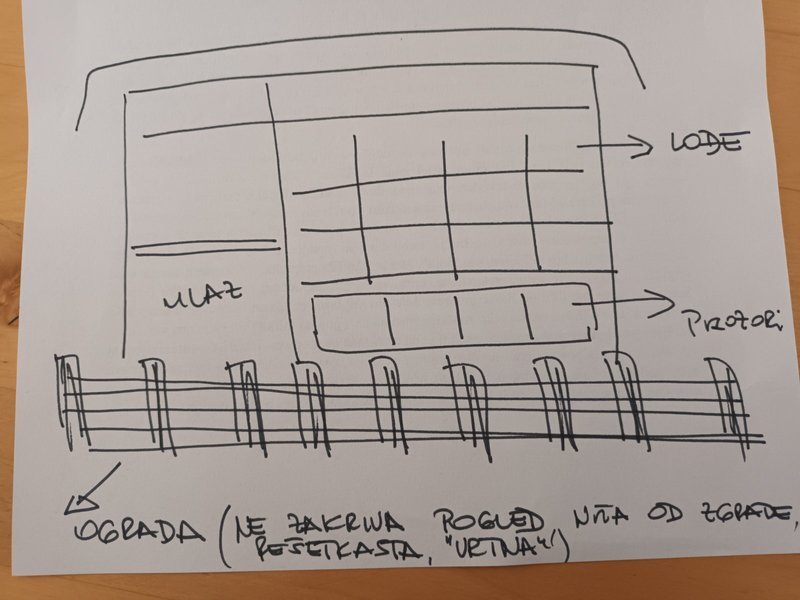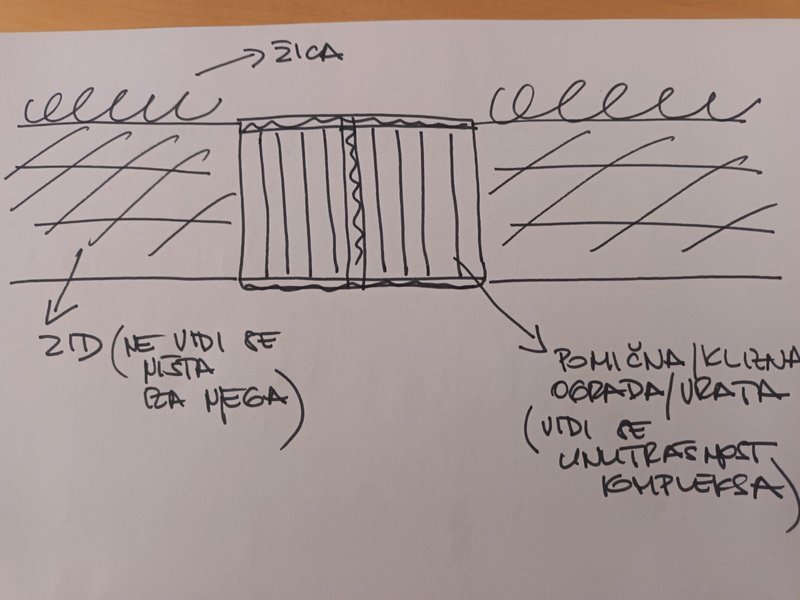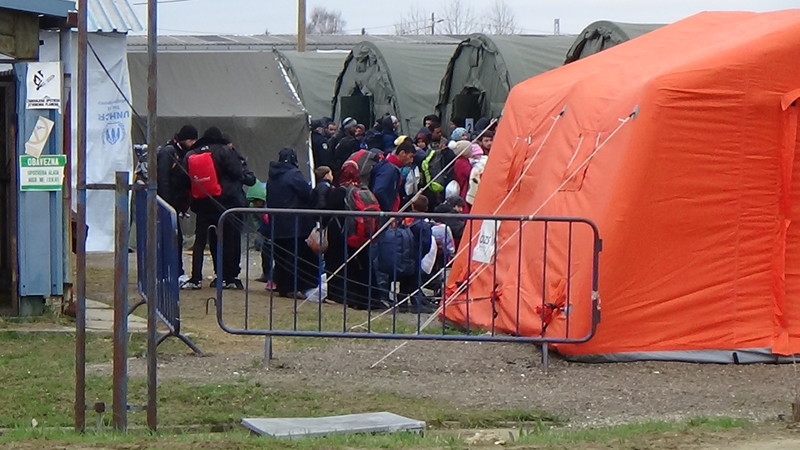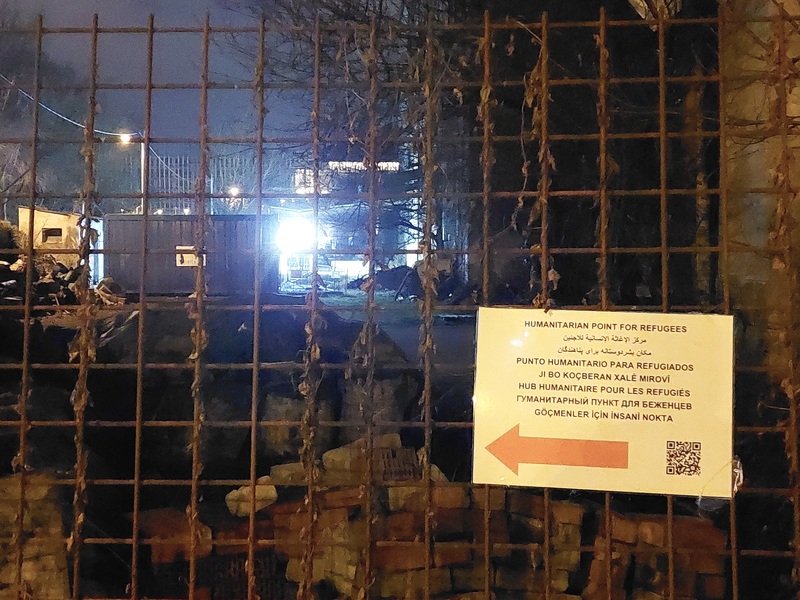Fences, Walls and Wires in the Interior
The system for monitoring the movement of migrants, in addition to barriers on external borders of territories, also includes barriers erected inside a territory that surround and intersect detention centers, shelters for asylum seekers, as well as places that are less obviously connected with irregularized migration. All such enclosed spaces can be seen as part of interiorized borders materialized in the form of different types of barriers that represent obstacles of varying degrees to those for whom they are intended. One such barrier is the one erected around Porin, the shelter for asylum seekers in Zagreb, which, despite its emphasized function of separation, could be described as a minor obstacle, or a more symbolic one when compared to the barrier around, for example, the Ježevo detention center, considering that it mostly does not prevent, although it directs, the exit of people from the shelter and entry into it. The barrier at Ježevo, in combination with other elements of the detention and surveillance system, prevents those imprisoned within it from exiting and communicating – although not necessarily all communication (cf. Protest against detention in Postojna) – with the physical environment of the center. The barrier that surrounds, under the official name, the Reception Centre for Foreigners in Ježevo (in a technical sense, it is actually a wall surrounding the complex, with a wire on top, and a movable metal fence/gate for entry and exit) evokes the image of certain state-border barriers, those along the external borders of a territory, with solid foundations and impenetrable properties. However, during certain periods, even the barrier around Porin, apart from dividing the area of the shelter from its surroundings and making it visually and in other ways distinctive, was, in combination with the rules regarding freedom of movement, very restrictive, precisely at the time – although it was planned beforehand – when it was built, at the beginning and during the COVID-19 epidemic (cf. Grubiša 2022: 6-8; Perić 2020).
 |
 |
| A sketch of the fence at Porin (left) and the wall around Ježevo (right). December 2022. Author and photo: Iva Pleše |
Large or small obstacles within a territory also include barriers around and inside other reception centers or camps in these areas, both recent ones and those erected during the long summer of migration, for example, the barriers in the distribution tent in the camp in Slavonski Brod, which separated the workers of humanitarian organizations and volunteers from the people on the move (Petrović 2018: 53), or those which, in combination with the police, acted as boundaries for the lines of people waiting (Škokić and Jambrešić Kirin 2018: 93). The camp in Slavonski Brod, as well as other camps and related areas, such as the reception center in Dobova, were not only surrounded by barriers, but barriers were also densely scattered within them (cf. Hameršak and Pleše 2018).
 |
 |
| The camp in Slavonski Brod. Fences. 1 March 2016. Photo: Marijana Hameršak |
 |
 |
| The camp in Slavonski Brod, fences in the distribution tent. Left: Before the arrival of the train. Photo: Tea Škokić. Right: The fence during transit, between the volunteers and people on the move. 1 March 2016. Photo: Marijana Hameršak |
Barriers within the territory erected because of migrants can also be found in less expected places, such as in Belgrade parks where, at the time of the closure of the Balkan corridor, plastic orange mesh barriers were placed around grassy areas in order to prevent migrants from accessing places to rest, and thus, along with other measures, to move them away from the city center (Beznec et al. 2016: 58). One recent barrier is the one along the so-called humanitarian station set up by the City of Zagreb at the end of 2022, near the main railway station, right next to the ruinous Paromlin building. The fence was old and obviously dangerous, patched together from various materials and parts, which is now used for this new function of separating people on the move from the “rest” of the city, in a tent dwelling which was to be used only during the day. The barrier, together with a plainclothes policeman, as we witnessed in mid-December 2022, also stops people who are not irregularized migrants from entering the space squeezed between the fence and Paromlin, with its two tents, several parked cars, muddy ground around the tent and a menacing ruin right next to it.
 |
 |
| The humanitarian station near Paromlin, Zagreb, December 2022 / January 2023. Photo: Iva Pleše and Mojca Piškor. |
Although, in contrast to physical obstacles along state borders which are relatively well covered in the media, but mostly not presented in more complex terms, fences within territories, those that are and especially those that are not part of the space officially designated for irregular migrants, are less written about and discussed, they are, as can be inferred from the examples stated above, definitely present and effective. They are referred to by the boy from Material Fatigue who, while traveling along one of the migration routes around Europe, after crossing the fence around a detention center and leaving a blanket with a printed inventory number on the barbed fence, tries to reach an unnamed city in the north: A fence. Fences everywhere; He had never seen so many fences before; Europe, it’s made up from corridors, overpasses, warehouses – and above all fences (Šindelka 2019: 8; 10; 28). Many of these barriers, it should be added, were not set up specifically for people on the move, but only in the experience of clandestine irregularized movement do they become real obstacles, like an overpass or a highway that needs to be covertly and dangerously crossed in order to, for instance, continue the journey through the forest. In this sense – preventing or hindering the movement of undesirables – fences in the interior of the territory do not differ from fences and other obstacles at state and other external, EU or Schengen borders, placed or erected specifically for people on the move.
16/1/2023
Literature
Beznec, Barbara, Marc Speer and Marta Stojić Mitrović. 2016. Governing the Balkan Route. Macedonia, Serbia and the European Border Regime. Beograd: Rosa Luxemburg Stiftung Southeast Europe.
Grubiša, Iva. 2022. „From Prison to Refuge and Back: The Interplay of Imprisonment and Creating a Sense of Home in the Reception Center for Asylum Seekers“. Journal of Borderlands Studies.
Hameršak, Marijana and Iva Pleše. 2018. "Winter Reception and Transit Center in the Republic of Croatia: An Ethnographic Research in theSlavonski Brod Refugee Camp". In Formation and Disintegration of the Balkan Refugee Corridor: Camps, Routes and Borders in the Croatian Context. Emina Bužinkić and Marijana Hameršak, eds. Zagreb: nstitute of Ethnology and Folklore Research (Zagreb), Centre for Peace Studies (Zagreb), Faculty of Political Science University of Zagreb – Centre for Ethnicity, Citizenship and Migration, bordermonitoring.eu e.V. (München), 109-142.
Perić, Ivana. 2020. „Ograda više, posao manje“. Radnička prava.
Petrović, Duško. 2018. "Humanitarian Exceptionalism: Normalization of Suspension of Law in Camp and Corridor". In Formation and Disintegration of the Balkan Refugee Corridor: Camps, Routes and Borders in the Croatian Context. Emina Bužinkić and Marijana Hameršak, eds. Zagreb: nstitute of Ethnology and Folklore Research (Zagreb), Centre for Peace Studies (Zagreb), Faculty of Political Science University of Zagreb – Centre for Ethnicity, Citizenship and Migration, bordermonitoring.eu e.V. (München), 43-62.
Šindelka, Marek. 2019. Zamor materijala. Zagreb: Ljevak. Translate Sanja Milićević Armada.
Škokić, Tea i Renata Jambrešić Kirin. 2018. „The Shopping Center of Abnormal Normality: Ethnography of the Distribution Tent in the Refugee Camp in Slavonski Brod“. In Formation and Disintegration of the Balkan Refugee Corridor: Camps, Routes and Borders in the Croatian Context. Emina Bužinkić and Marijana Hameršak, eds. Zagreb: nstitute of Ethnology and Folklore Research (Zagreb), Centre for Peace Studies (Zagreb), Faculty of Political Science University of Zagreb – Centre for Ethnicity, Citizenship and Migration, bordermonitoring.eu e.V. (München), 87-107.